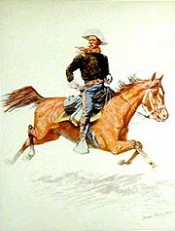Davis Richard Harding

Frederic Sackrider Remington (October 4, 1861 - December 26, 1909) was an American painter, illustrator, sculptor, and writer who specialized in depictions of the Old American West, specifically concentrating on the last quarter of the 19th century American West and images of cowboys, American Indians, and the U.S. Cavalry. Remington was born in Canton, New York in 1861 to Seth Pierre Remington[1] (1830-1880) and Clara Bascomb Sackrider,[2] whose paternal family owned hardware stores and emigrated from Alsace-Lorraine in the early 1700’s.[3] Remington’s father was a colonel in the Civil War whose family arrived in the United States from England in 1637. He was a newspaper editor and postmaster, and the family was active in local politics and staunchly Republican. One of Remington’s great grandfathers, Samuel Bascom, was a saddle maker by trade, and the Remingtons were fine horsemen. Frederic Remington was related by family bloodlines to Indian portrait artist George Catlin and cowboy sculptor Earl W. Bascom. Colonel Remington was away at war during most of the first four years of his son’s life. After the war, he moved his family to Bloomington, Illinois for a brief time and was appointed editor of the Bloomington Republican, but the family returned to Canton in 1867.[4] Remington was the only child of the marriage, and received constant attention and approval. He was an active child, large and strong for his age, who loved to hunt, swim, ride, and go camping. He was a poor student, though, particularly in math, which did not bode well for his father’s ambitions for his son to attend West Point. He began to make drawings and sketches of soldiers and cowboys at an early age. The family moved to Ogdensburg, New York when Remington was eleven and he attended Vermont Episcopal Institute, a church-run military school, where his father hoped discipline would rein in his son’s lack of focus, and perhaps lead to a military career. Remington took his first drawing lessons at the Institute. He then transferred to another military school where his classmates found the young Remington to be a pleasant fellow, a bit careless and lazy, good-humored, and generous of spirit, but definitely not soldier material.[5] He enjoyed making caricatures and silhouettes of his classmates. At sixteen, he wrote to his uncle of his modest ambitions, “I never intend to do any great amount of labor. I have but one short life and do not aspire to wealth or fame in a degree which could only be obtained by an extraordinary effort on my part”.[6] He imagined a career for himself as a journalist, with art as a sideline. Remington attended the art school at Yale University, the only male in the freshman year. However, he found that football and boxing were more interesting than the formal art training, particularly drawing from casts and still life objects. He preferred action drawing and his first published illustration was a cartoon of a “bandaged football player” for the student newspaper Yale Courant.[7]. Though he was not a star player, his participation on the strong Yale football team was a great source of pride for Remington and his family. He left Yale in 1879 to tend to his ailing father who had tuberculosis. His father died a year later, at age forty-six, receiving respectful recognition from the citizens of Ogdensburg. Remington’s Uncle Mart secured a good paying clerical job for his nephew in Albany, New York and Remington would return home on weekends to see his girlfriend Eva Caten. After the rejection of his engagement proposal to Eva by her father, Remington became a reporter for his Uncle Mart’s newspaper, then went on to other short-lived jobs. Living off his inheritance and modest work income, Remington refused to go back to art school and instead spent time camping and enjoying himself. At nineteen, he made his first trip west, going to Montana, at first to buy a cattle operation then a mining interest but realized he did not have sufficient capital for either. In the Ol’ West of 1881, he saw the vast prairies, the quickly shrinking buffalo herds, the still unfenced cattle, and the last major confrontations of U.S. Cavalry and native American tribes, scenes he had imagined since his childhood. He also hunted grizzly bears with Montague Stevens in New Mexico in 1895 .[8] Though the trip was undertaken as a lark, it gave Remington a more authentic view of the West than some of the later artists and writers who followed in his footsteps, such as N. C. Wyeth and Zane Grey, who arrived twenty-five years later when the Ol’ West had slipped into history. From that first trip, Harper's Weekly published Remington’s first published commercial effort, a re-drawing of a quick sketch on wrapping paper that he had mailed back East.[9] In 1883, Remington went to rural Peabody, Kansas,[10][11][12] to try his hand at the booming sheep ranching and wool trade, as one of the “holiday stockmen”, rich young Easterners out to make a quick killing as ranch owners. He invested his entire inheritance but Remington found ranching to be a rough, boring, isolated occupation which deprived him of the finer things of Eastern life, and the real ranchers thought him a lazy playboy.[13] Remington continued sketching but at this point his results were still cartoonish and amateurish. After less than a year, he sold his ranch and went home. After acquiring more capital from his mother, he returned to Kansas City to start a hardware business, but due to an alleged swindle it failed, and he reinvested his remaining money as a silent, half owner of a saloon. He went home to marry Eva Caten in 1884 and they returned to Kansas City immediately. She was unhappy with his saloon life and was unimpressed by the sketches of saloon inhabitants that Remington regularly showed her. When his real occupation became known, she left her husband and returned to Ogdensburg.[14] With his wife gone and with business doing badly, Remington started to sketch and paint in earnest, and bartered his sketches for essentials. He soon had enough success selling his paintings to locals to see art as a real profession. Remington returned home again, his inheritance gone but his faith in his new career secured, reunited with his wife and moved to Brooklyn. He began studies at the Art Students League of New York and significantly bolstered his fresh though still rough technique. His timing was excellent as newspaper interest in the dying West was escalating. He submitted illustrations, sketches, and other works for publication with Western themes to Collier's and Harper's Weekly, as his recent Western experiences (highly exaggerated) and his hearty, breezy “cowboy” demeanor gained him credibility with the eastern publishers looking for authenticity.[15] His first full page cover under his own name appeared in Harper's Weekly on January 9, 1886, when he was twenty-five. With financial backing from his Uncle Bill, Remington was able to pursue his art career and support his wife After returning back East, Remington was sent by Harper's Weekly to cover the Charleston, South Carolina earthquake of 1886. To expand his commission work, he also began doing drawings for Outing magazine. His first year as a commercial artist had been successful, earning Remington $1,200, almost triple that of a typical teacher.[17] He had found his life’s work and bragged to a friend, “That’s a pretty good break for an ex cow-puncher to come to New York with $30 and catch on it ‘art’." [18] For commercial reproduction in black-and-white, he produced ink and wash drawings. As he added watercolor, he began to sell his work in art exhibitions. His works were selling well but garnered no prizes, as the competition was strong and masters like Winslow Homer and Eastman Johnson were considered his superiors. A trip to Canada in 1887, produced illustrations of the Blackfoot, the Crow Nation, and the Canadian Mounties, eagerly enjoyed by the reading public. Later that year, Remington received a commission to do eighty-three illustrations for a book by Theodore Roosevelt, Ranch Life and the Hunting Trail, to be serialized in The Century Magazine before publication.[19] The twenty-five year old Roosevelt had a similar Western adventure to Remington, losing money on a ranch in North Dakota the previous year but gaining experience which made him an “expert” on the West. The assignment gave Remington’s career a big boost and forged a lifelong connection with Roosevelt. His full-color oil painting Return of the Blackfoot War Party was exhibited at the National Academy of Design and the New York Herald commented that Remington would “one day be listed among our great American painters”.[20] Though not admired by all critics, Remington’s work was deemed “distinctive” and “modern”. By now, he was demonstrating the ability to handle complex compositions with ease, as in Mule Train Crossing the Sierras (1888), and to show action from all points of view[21] His status as the new trendsetter in Western art was solidified in 1889 when he won a second-class medal at the Paris Exposition. He had been selected by the American committee to represent American painting, over Albert Bierstadt whose majestic, large-scale landscapes peopled with tiny figures of pioneers and Indians was now considered passé. His first one-man show, in 1890, presented twenty-one paintings at the American Art Galleries and was very well received. With success all but assured, Remington became established in society. His personality, his “pseudo-cowboy” speaking manner, and “Wild West” reputation were strong social attractions. His biography falsely promoted some of the myths he encouraged about his Western experiences.[23] Remington’s regular attendance at celebrity banquets and stag dinners, however, though helpful to his career, fostered prodigious eating and drinking which caused his girth to expand alarmingly. Obesity became a constant problem for him from then on. Among his urban friends and fellow artists, he was “a man among men, a deuce of a good fellow” but notable because he (facetiously) “never drew but two women in his life, and they were failures” (not counting Indian women).[24]
do you like this author?
What readers are saying
What do you think? Write your own comment on this book!
write a commentWhat readers are saying
What do you think? Write your own comment on this author!
write a commentBook list

her first appearance
Series:
Unknown
Year:
Unknown
Raiting:
4/5
With illustrations by C. D. Gibson and E. M. Ashe. This Elibron Classics book is a facsimile reprint of a 1901 edition by Harper & Brothers Publishers, New York; London. --This text refers to an alternate Paperback edition.
Show more
add to favoritesadd In favorites

farces the dictator the galloper miss civilization
Series:
Unknown
Year:
Unknown
Raiting:
4.5/5
This scarce antiquarian book is included in our special Legacy Reprint Series. In the interest of creating a more extensive selection of rare historical book reprints, we have chosen to reproduce this title even though it may possibly have occasional imperfections such as missing and blurred pages, missing text, poor pictures, markings, dark backgrounds and other reproduction issues beyond our control. Because this work is culturally important, we have made it available as a part of our commitment to protecting, preserving and promoting the world's literature. --This text refers to the Paperback edition.
Show more
add to favoritesadd In favorites
Book list

her first appearance
Series:
Unknown
Year:
Unknown
Raiting:
4/5
With illustrations by C. D. Gibson and E. M. Ashe. This Elibron Classics book is a facsimile reprint of a 1901 edition by Harper & Brothers Publishers, New York; London. --This text refers to an alternate Paperback edition.
Show more
add to favoritesadd In favorites

farces the dictator the galloper miss civilization
Series:
Unknown
Year:
Unknown
Raiting:
4.5/5
This scarce antiquarian book is included in our special Legacy Reprint Series. In the interest of creating a more extensive selection of rare historical book reprints, we have chosen to reproduce this title even though it may possibly have occasional imperfections such as missing and blurred pages, missing text, poor pictures, markings, dark backgrounds and other reproduction issues beyond our control. Because this work is culturally important, we have made it available as a part of our commitment to protecting, preserving and promoting the world's literature. --This text refers to the Paperback edition.
Show more
add to favoritesadd In favorites

dr jamesons raiders vs the johannesburg reformers
Series:
Unknown
Year:
Unknown
Raiting:
3/5
Show more
add to favoritesadd In favorites

about paris
Series:
Unknown
Year:
Unknown
Raiting:
3.5/5
Purchase of this book includes free trial access to www.million-books.com where you can read more than a million books for free. This is an OCR edition with typos. Excerpt from book: Ill PARIS IN MOURNING HE news of the assassination of President Carnot at Lyons reached Paris and the Cafe de la Paix at ten o'clock on Sunday night. What is told at the Cafe de la Paix is not long in traversing the length of the boulevards, and in crossing the Place de la Concorde to the cafes chan- tants and the public gardens in the Champs Elysees, so that by eleven o'clock on the night of the 24th of June " all Paris" was acquainted with the fact that the President of the Republic had been cruelly murdered. There are many people in America who remember thenight when President Garfield died, and how, when his death was announced from the stage of the different theatres, the audience in each theatre rose silently as one man and walked quietly out. To them the President's death was not unexpected; it did not stun them, it came with no sudden shock, but it was not necessary to announce to them that the performance for that evening was at an end. They did not leave because the manager had rung down the curtain, but because at such a time they felt more at ease with themselves outside of a place of amusement than in one. This was not the feeling of the Parisians when President Carnot died. On that night no lights were put out in the cafes; no leader's baton rapped for a sudden silence in the Jardin de Paris, and the Parisians continued to drink their bock and to dance, or to watch others dance, even though they knew that at that same moment Madame Carnot in a special train was hurrying through the night to reach the death-bed of her husband. It is never possible to tell which way the French people will jump, or how they will act at a crisis. They have no precedents of conduct; they are as likely to do the characteristic thing, which in itself is differentfrom what people...
Show more
add to favoritesadd In favorites

a year from a reporters note book
Series:
Unknown
Year:
Unknown
Raiting:
4/5
Purchase of this book includes free trial access to www.million-books.com where you can read more than a million books for free. This is an OCR edition with typos. Excerpt from book: CUBA IN WAR-TIME I.-THE DEATH OF RODRIGUEZ ADOLFO RODRIGUEZ was the only son of a Cuban farmer, who lives nine miles outside of Santa Clara, beyond the hills that surround that city to the north. When the revolution broke out young Rodriguez joined the insurgents, leaving his father and mother and two sisters at the farm. He was taken, in December of 1896, by a force of the Guardia Civile, the corps d'élite of the Spanish army, and defended himself when they tried to capture him, wounding three of them with his machete. He was tried by a military court for bearing arms against the government, andsentenced to be shot by a fusillade some morning before sunrise. Previous to execution he was confined in the military prison of Santa Clara with thirty other insurgents, all of whom were sentenced to be shot, one after the other, on mornings following the execution of Rodriguez. His execution took place the morning of the i gth of January, 1897, at a place a half- mile distant from the city, on the great plain that stretches from the forts out to the hills, beyond which Rodriguez had lived for nineteen years. At the time of his death he was twenty years old. I witnessed his execution, and what follows is an account of the way he went to death. The young man's friends could not be present, for it was impossible for them to show themselves in that crowd and that place with wisdom or without distress, and I like to think that, although Rodriguez could not know it, there was one person present when he died who felt keenly for THE DEATH OF RODRIGUEZ him, and who was a sympathetic though unwilling spectator. There had been a full moon the night preceding the execution, and when the squad of soldiers marched out from town it was still shining brightly through the mi...
Show more
add to favoritesadd In favorites

A Wasted Day
Series:
Unknown
Year:
Unknown
Raiting:
1.5/5
By Richard Harding Davis, one of the most active and influential journalists during the Spanish-American War, as well as the writer of fiction and drama.
Show more
add to favoritesadd In favorites

Vera, the Medium
Series:
Unknown
Year:
Unknown
Raiting:
5/5
This volume is produced from digital images created through the University of Michigan University Library's preservation reformatting program. The Library seeks to preserve the intellectual content of items in a manner that facilitates and promotes a variety of uses. The digital reformatting process results in an electronic version of the text that can both be accessed online and used to create new print copies. This book and thousands of others can be found in the digital collections of the University of Michigan Library. The University Library also understands and values the utility of print, and makes reprints available through its Scholarly Publishing Office.
Show more
add to favoritesadd In favorites

The Spy
Series:
Unknown
Year:
Unknown
Raiting:
3.5/5
My going to Valencia was entirely an accident. But the more often I stated that fact, the more satisfied was everyone at the capital that I had come on some secret mission. Even the venerable politician who acted as our minister, the night of my arrival, after dinner, said confidentially, "Now, Mr. Crosby, between ourselves, what's the game?"
Show more
add to favoritesadd In favorites

Somewhere in France
Series:
Unknown
Year:
Unknown
Raiting:
4.5/5
Work from the popular writer of fiction and drama, journalist, war correspondent and editor of 'Harpers Weekly' --This text refers to an alternate Paperback edition.
Show more
add to favoritesadd In favorites

The Reporter Who Made Himself King
Series:
Unknown
Year:
Unknown
Raiting:
3.5/5
Webster's edition of this classic is organized to expose the reader to a maximum number of synonyms and antonyms for difficult and often ambiguous English words that are encountered in other works of literature, conversation, or academic examinations. Extremely rare or idiosyncratic words and expressions are given lower priority in the notes compared to words which are ¿difficult, and often encountered¿ in examinations. Rather than supply a single synonym, many are provided for a variety of meanings, allowing readers to better grasp the ambiguity of the English language, and avoid using the notes as a pure crutch. Having the reader decipher a word's meaning within context serves to improve vocabulary retention and understanding. Each page covers words not already highlighted on previous pages. If a difficult word is not noted on a page, chances are that it has been highlighted on a previous page. A more complete thesaurus is supplied at the end of the book; synonyms and antonyms are extracted from Webster's Online Dictionary. PSAT¿ is a registered trademark of the College Entrance Examination Board and the National Merit Scholarship Corporation neither of which sponsors or endorses this book; SAT¿ is a registered trademark of the College Board which neither sponsors nor endorses this book; GRE¿, AP¿ and Advanced Placement¿ are registered trademarks of the Educational Testing Service which neither sponsors nor endorses this book, GMAT¿ is a registered trademark of the Graduate Management Admissions Council which is neither affiliated with this book nor endorses this book, LSAT¿ is a registered trademark of the Law School Admissions Council which neither sponsors nor endorses this product. All rights reserved.
Show more
add to favoritesadd In favorites
What readers are saying
What do you think? Write your own comment on this author!
write a commentif you like Davis Richard Harding try:
readers also enjoyed
What readers are saying
What do you think? Write your own comment on this author!
write a commentGenre
if you like Davis Richard Harding try:
readers also enjoyed
Do you want to exchange books? It’s EASY!
Get registered and find other users who want to give their favourite books to good hands!

